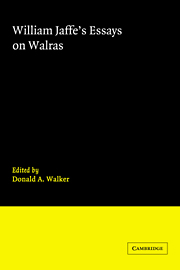Book contents
- Frontmatter
- Contents
- Preface
- Acknowledgments
- Introduction
- PART I WALRAS'S BIOGRAPHY
- PART II THE GENESIS AND DEVELOPMENT OF WALRAS'S IDEAS
- PART III THE SCOPE OF WALRAS'S WORK
- PART IV SPECIAL TOPICS IN WALRAS'S ECONOMICS
- 9 Léon Walras' theory of capital accumulation (1942)
- 10 Walras's theory of capital formation in the framework of his theory of general equilibrium (1953)
- 11 New light on an old quarrel: Barone's unpublished review of Wicksteed's “Essay on the coordination of the laws of distribution” and related documents (1964)
- 12 The Walras-Poincaré correspondence on the cardinal measurability of utility (1977)
- 13 Walras' theory of tâtonnement: a critique of recent interpretations (1967)
- 14 Another look at Léon Walras's theory of tâtonnement (1981)
- PART V WALRAS'S PLACE IN THE HISTORY OF ECONOMIC THOUGHT
- Index
10 - Walras's theory of capital formation in the framework of his theory of general equilibrium (1953)
Published online by Cambridge University Press: 05 May 2010
- Frontmatter
- Contents
- Preface
- Acknowledgments
- Introduction
- PART I WALRAS'S BIOGRAPHY
- PART II THE GENESIS AND DEVELOPMENT OF WALRAS'S IDEAS
- PART III THE SCOPE OF WALRAS'S WORK
- PART IV SPECIAL TOPICS IN WALRAS'S ECONOMICS
- 9 Léon Walras' theory of capital accumulation (1942)
- 10 Walras's theory of capital formation in the framework of his theory of general equilibrium (1953)
- 11 New light on an old quarrel: Barone's unpublished review of Wicksteed's “Essay on the coordination of the laws of distribution” and related documents (1964)
- 12 The Walras-Poincaré correspondence on the cardinal measurability of utility (1977)
- 13 Walras' theory of tâtonnement: a critique of recent interpretations (1967)
- 14 Another look at Léon Walras's theory of tâtonnement (1981)
- PART V WALRAS'S PLACE IN THE HISTORY OF ECONOMIC THOUGHT
- Index
Summary
Probably the most difficult component of the Elements of Pure Economics is Part V of the definitive edition, entitled “Theory of Capital Formation and Credit.” The proof of its difficulty, even for its most erudite readers, is revealed by the paucity of commentaries published on that part and by the abundance of unpublished correspondence that deals with that aspect of the Walrasian system. That it constituted for Walras himself a veritable stumbling block is equally well demonstrated by the numerous revisions that he made to his theory of capital formation in the course of the successive editions of the Elements that appeared during his lifetime. These revisions not only dealt with the substance but also affected the location of the theory in his system of general equilibrium. In fact, if one wishes to achieve a better comprehension of the theory, it is necessary to follow it through the changes to which it has been submitted in its successive versions, and to consider it from the point of view of the place it occupies in the totality of Walras's system. This is what I propose to do in this study.
If we refer to the first edition (1874–7), we see that Walras posed the problem but did not get very far in his efforts to solve it. He posed the problem at the very beginning of Part V of the first edition, entitled “Conditions and Consequences of Economic Progress.”
- Type
- Chapter
- Information
- William Jaffe's Essays on Walras , pp. 151 - 175Publisher: Cambridge University PressPrint publication year: 1983
- 2
- Cited by



